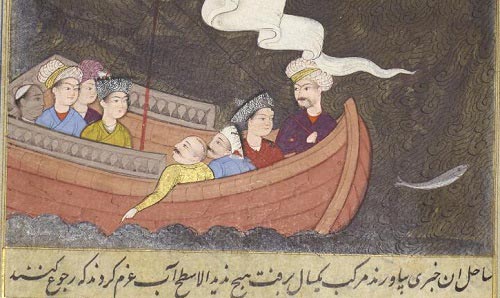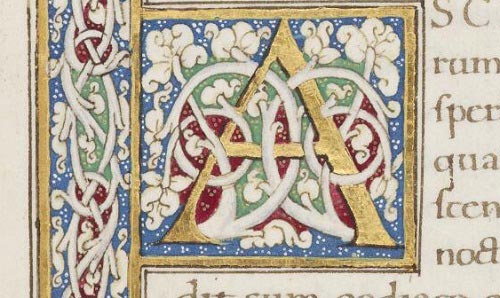
Visual Collections
Visual collections is a term that we use to cover the collections of art, visual and material culture.
Reduced-size2.jpg)
This means our paintings, drawings, photographs, sculptures, objects, textiles, ceramics, and prints, illustrations in books and illuminations in manuscripts.
Our visual collections date from the ancient world to the present and their scope is international, covering areas as diverse as Renaissance print culture; post-World War II avant-garde art movements; the art and illustration of science, technology and medicine; 19th-century British art; and the visual cultures of the Near, Middle and Far East.
There are a number of discrete collections within our four main collecting areas, which are fine art, decorative art, photography and evocative objects. There are also hybrid collections (for example mixed collections of archival materials and artworks) and many more items of visual material and material culture (objects) spread across all our formats and library sites.
Visual and literary cultures
The Library has a wealth of material that links visual and literary cultures, from the Ancient Egyptian Book of the Dead to contemporary artists' books and Private Press productions. Especially rich are the Post World War II avant-garde international art and 'counter cultural' movements. Art works, typestracts, 'zines and artists books survive in the collections of concrete poet and Benedictine monk dom sylvester houēdard, multi-media artist Li Yuan-chia and poet Jeff Nuttall, which offer opportunities for interdisciplinary study.
Analogue photography
The Rylands collection of analogue photography contains a comprehensive range of subjects, from art to zoology, in a variety of analogue formats and processes, from the calotype to the Polaroid.
The scope of the collection is international with an excellent representation of national and local photography, especially works featuring Manchester, the North West or the North of England. There are works from early photographers like William Henry Fox Talbot, Julia Margaret Cameron, Roger Fenton and Alvin Langdon Coburn, but also recent and contemporary photographers such as Fay Godwin, Li Yuan-chia, Martin Parr and Richard Davies. Particularly exciting are examples of early domestic photography, like the Langford Brooke glass plate collection, which contains images of an early 20th-century local family that lived at Mere Hall, Cheshire, documenting their family life.
There are also a good number of early British photographic books (1840s-1900) as well as sets of some significant 20th-century photo-magazines, including Picture Post. In addition, the collection features associated objects including cameras, tripods and stereoscopes.
The Rylands collection of analogue photography contains a comprehensive range of subjects, from art to zoology, in a variety of analogue formats and processes, from the calotype to the Polaroid.
The scope of the collection is international with an excellent representation of national and local photography, especially works featuring Manchester, the North West or the North of England. There are works from early photographers like William Henry Fox Talbot, Julia Margaret Cameron, Roger Fenton and Alvin Langdon Coburn, but also recent and contemporary photographers such as Fay Godwin, Li Yuan-chia, Martin Parr and Richard Davies. Particularly exciting are examples of early domestic photography, like the Langford Brooke glass plate collection, which contains images of an early 20th-century local family that lived at Mere Hall, Cheshire, documenting their family life.
There are also a good number of early British photographic books (1840s-1900) as well as sets of some significant 20th-century photo-magazines, including Picture Post. In addition, the collection features associated objects including cameras, tripods and stereoscopes.
Portraits
Our collection of portraits encompasses paintings, miniatures, drawings, sculptures, photographs, engravings, ceramics and bone. These works depict a vast array of individuals from a range of cultures and historical periods. One of the Library’s most famous portraits is the ‘Portrait of a Young Man’, which is commonly referred to as the Grafton Portrait. Noted for its supposed resemblance to a young William Shakespeare, it is by an unknown English artist and dates from 1588.
Art and illustration of science, technology and medicine
The art and illustration of science, technology and medicine is well represented in our archives and book and manuscript collections in the form of notebooks, drawings, diagrams, photographs and printed images. There are early medical alchemical and astrological manuscripts as well as illustrated printed works on anatomy, midwifery and early surgery. The collections of 19th-century obstetrician Thomas Radford and 20th-century medical illustrator Dorothy Davison are particularly rich sources for clinical illustration. Amongst other Manchester physicians, Dorothy Davison worked with the neurosurgeon Sir Geoffrey Jefferson who was a great exponent of the value of medical illustrations and this working relationship is reflected in her surviving works. The Library also holds a significant collection of Jefferson’s patient case files, a number of which relate directly to Davison’s drawings.
Visual print culture
The Rylands’ examples of visual print culture range from the 15th century to the present (including maps, portfolios, albums and printed books)and cover a spectrum of subjects, and a range of different techniques including relief, intaglio, planographic and screen printing. The collections include works by Nicolas Poussin, Claude Mellan, Marcantonio Raimondi, William Hogarth, William Blake and Ian Hamilton Finlay.
The Holtorp Collection, assembled by the 19th-century Polish collector and designer Hiero von Holtorp, is an especially rich source for the study of Renaissance prints and contains works by Northern and Italian masters including Albrecht Durer, Hans Burkmair and Andrea Mantegna.
Book art and manuscripts
The Rylands has excellent collections of illuminated books of hours, Gospel books and medieval romances in the Western (European) manuscripts [link to follow], as well as large Persian, Arabic and Hebrew collections that contain beautiful examples of decoration, illumination and miniature illustrations. Many of the manuscript collections include fine examples of calligraphy and book art either in the form of illustrated and illuminated manuscripts, or of material culture in exquisite original bindings, medieval jewelled book covers and ivory carvings.
The Rylands also houses beautiful sets of Chinese and Indian drawings, including some superb 19th-century Chinese pith paintings. The recent discovery of a complete set of engravings of ‘European Palaces in Yuan Ming Yuan’ at the Rylands Library was a most significant find for the study of 18th-century China. The Manchester set uniquely contains a hand coloured plate; it is however unfinished, as the artist died before completing the colouring.
Architectural, urban design and landscape history
Architectural and landscape history features across our collections and includes treatises and surveys which range from Alberti and Palladio to Robert Adam, Sir John Soane and Joseph Nash. We also hold extensive collections of atlases and travelogues. Additionally, urban design and development, particularly of Manchester and the North West of England, are very well documented in our Map Collection [link to follow], while the papers of Sir Raymond Unwin (1863-1940), one of the leading architects and town planners of the first half of the 20th century, constitute an important source for the garden city movement.
Object collections
In every library, there are personal relics, ephemera and oddities. The study of materiality and material culture is of increasing interest to scholars, especially in the fields of historical study, museum studies, sociology and anthropology.
In the Rylands we have objects connected to various artists, likely kept as ‘relics’ or souvenirs. For example, the poet Walt Whitman’s hat, hair and pen nibs; electronic composer Delia Derbyshire’s gas mask from her childhood in Coventry in the 1940s; numerous locks of hair including locks belonging at one time to Marcel Proust and William Wordsworth. As well as personal items, we also have many objects in the Library and in our collections that tell the history of writing and printing, including quills and other writing implements, printing presses, typewriters, cameras and the tools of artistic practice.
List of collections
Physical collections
- Windmill and Watermill Collection of Edward Mitford Abraham
- Arabic Manuscripts
- Architectural Printed Works
- Armenian Manuscripts
- British Victorian Photography Collection
- Children's Printed Collection
- Chinese Collection
- Alvin Langdon Coburn Photography Collection
- Walter Crane Archive
- Anthony Dowd Bindings Collection
- Dutch Manuscripts
- English Manuscripts
- Allen Freer Papers
- French Manuscripts
- German Manuscripts
- Greek Manuscripts
- Hebrew Manuscripts
- Hiero von Holtorp Collection
- dom sylvester houédard Book Collection
- dom sylvester houédard Papers
- Illustrated Books
- Incunabula Collection
- Italian Manuscripts
- Japanese Collection
- Sir Geoffrey Jefferson Papers
- George Johnson Wood-Engraving Collection
- Latin Manuscripts
- Li Yuan-chia Archive
- Manchester Geographical Society Photographic Slides Collection
- Jeff Nuttall Papers
- Martin Parr Photography Collection
- Persian Manuscripts
- Photography Collection
- Margaret Pilkington Papers
- Private Press Collection
- Stephen Raw Papers
- Samaritan Manuscripts
- South-East Asian Manuscripts
- Syriac Manuscripts
- Alan Tabor Calligraphy Collection
- Tregaskis Bindings Collections
- Turkish Manuscripts
- Sir Raymond Unwin Papers
- Mark Warner Photography Collection
Digital collections
- Bible Illustrations in Manchester Digital Collections
- Early Photographic Albums in Manchester Digital Collections
- Gaster Amulets in Manchester Digital Collections
- Hebrew Manuscripts in Manchester Digital Collections
- Latin Manuscripts in Manchester Digital Collections
- Papyrus to Print: Text and Image in Manchester Digital Collections
- Persian Manuscripts in Manchester Digital Collections
- Photo Jewellery in Manchester Digital Collections
- Syriac Manuscripts in Manchester Digital Collections
Further information
Related subject pages
- Africa Collections
- Ahmed Iqbal Ullah RACE Centre Collections
- British Pop Archive
- Classics and Ancient History Collections
- East Asia Collections
- English Literature Collections
- European Literature Collections
- History of Art and Architecture Collections
- History of the Book Collections
- Jewish Studies Collections
- Maps, Travel and Discovery Collections
- Middle East Collections
- Modern Literary Archives
- Performing Arts Collections
- South Asia Collections
- Western European Manuscript Collections

Exploring subject areas
An overview of our Special Collections, including information about the background and history of our holdings.

Special Collections A-Z
Explore the Special Collections through the collection names and descriptions using our searchable A-Z tool.
